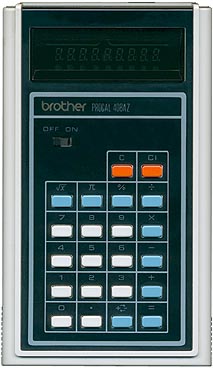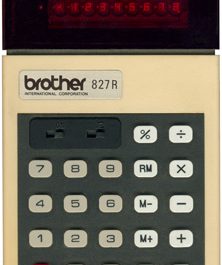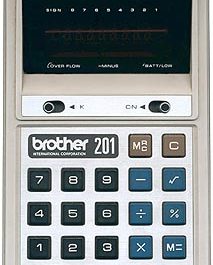
The Brother 408AZ is a handheld calculator from 1976. It measures approximately 85mm x 145mm x 20mm and weighs 132g without batteries. Power is supplied by 4 AA batteries or by an AC adapter that plugs into a socket on the top of the calculator.
The case consists of two white plastic pieces, with a black plastic front section that contains the keyboard. The keys are medium travel with a soft click. The display is an 8-digit green vacuum fluorescent display, with a 9th digit used for indicating negatives and errors.
The 408AZ performs the standard four functions of addition, subtraction, multiplication and division. It also has percentage, square root, sign change and pi keys. The calculator employs automatic constant on all arithmetic operations. Input overflow is not suppressed, allowing entry of up to 9 digits, which can cause errors if more than 8 digits are entered. Errors display an ‘E’ in the 9th digit and can be cleared with the ‘CI’ (clear incorrect entry) key. Divide by zero also shows ‘E’ and is unrecoverable.

Negative numbers display a minus sign in the leftmost digit, shifting the number right to maintain an 8 digit capacity. Negative square roots are allowed, resulting in a negative number. The change sign key can be used mid-number entry but not prior. No major logic bugs were found.
The main integrated circuit is a 28-pin NEC uPD940C dating from mid-1975. Other components include a 9-digit Itron vacuum fluorescent display, 2 transistors, 9 diodes, 7 capacitors, 1 resistor array, and 4 resistors. The two circuit boards are connected by 10 wires.
Overall, the 408AZ has a quality feel and slim, sturdy construction. The large bright display contributes to a premium impression. More advanced logic with overflow suppression and full error recovery would improve functionality. But the 408AZ provides a basic set of math functions in a well-designed package for its time.


